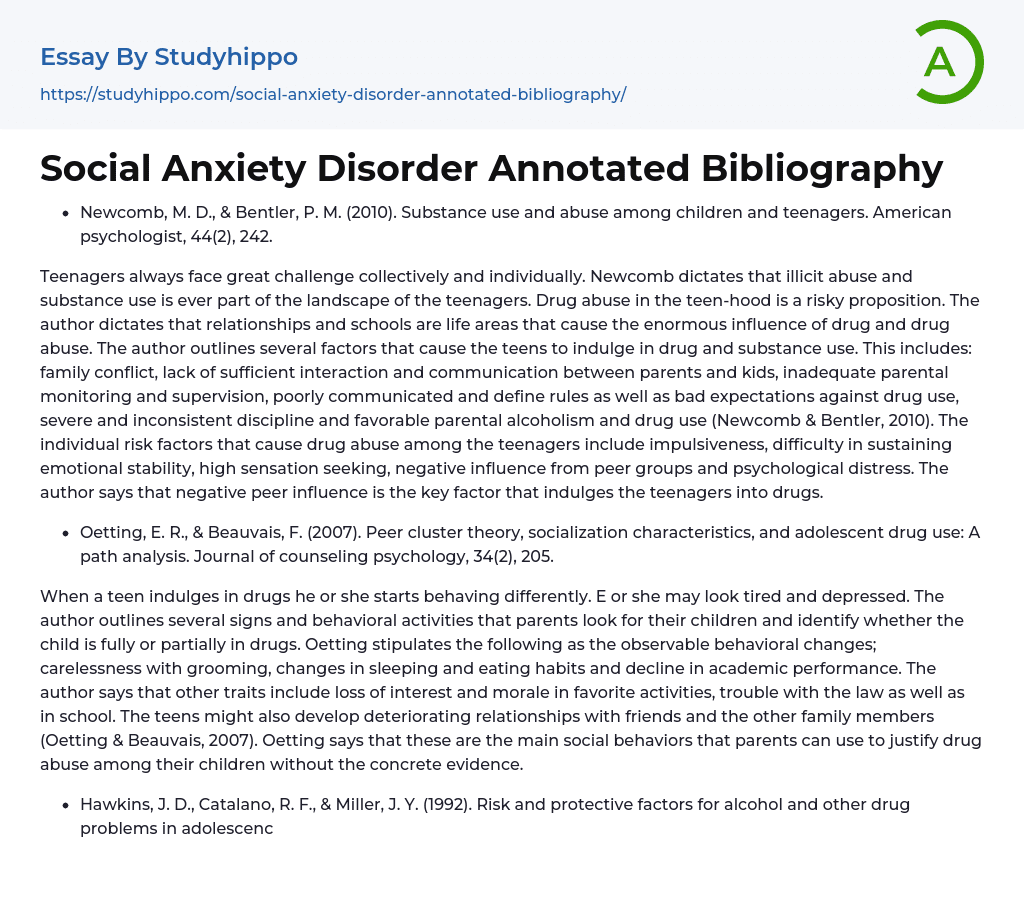

Social Anxiety Disorder Annotated Bibliography Essay Example
- Newcomb, M. D., & Bentler, P. M. (2010). Substance use and abuse among children and teenagers. American psychologist, 44(2), 242.
According to Newcomb, substance abuse and illicit drug use are ongoing issues for teenagers as a group and as individuals.
The author discusses the risks of drug abuse during the teenage years, particularly in relationships and schools. They identify several factors that contribute to drug and substance use among teens, including family conflict, lack of communication between parents and children, inadequate parental supervision, unclear rules and expectations regarding drug use, inconsistent discipline, and parental alcoholism or drug use (Newcomb & Bentler, 2010). Additionally, individual risk factors for teen drug abuse include impulsiveness, difficulty managing emotions, a desire for sensation-seeking experiences, negative peer influence, and psychological distress. According to the author, negative peer influence is a signif
...icant factor in influencing teenagers to use drugs.
- Oetting, E. R., & Beauvais, F. (2007). Peer cluster theory, socialization characteristics, and adolescent drug use: A path analysis. Journal of counseling psychology, 34(2), 205.
When a teenager engages in drug use, they display various behavioral changes such as appearing tired and depressed. According to Oetting, parents can identify if their child is partially or fully involved in drug use by observing certain signs and behaviors. These include neglecting personal grooming, alterations in sleep and eating patterns, and a decline in academic performance.
The author discusses the signs of drug abuse in teenagers, such as a loss of interest in once-enjoyed activities, problems with the law and in school, and deteriorating relationships with friends and family members (Oetting & Beauvais, 2007). Oetting emphasizes that recognizing these social behaviors is important for parents to identify their children's drug
abuse, even without concrete evidence.
According to Hawkins, J. D., Catalano, R. F., & Miller, J. Y. (1992), there are risk and protective factors for alcohol and other drug problems during adolescence and early adulthood that have implications for preventing substance abuse. Parents should consider these factors.
Hawkins also suggests that teenagers who abuse drugs may suffer from physical diseases and disabilities due to overdosing on drugs. The author further points out that a higher proportion of young people involved with alcohol are at an increased risk of experiencing homicide, suicide, illness, and accidents.
The author suggests that young individuals may partake in immoral actions, such as engaging in sexual activities, especially when they are influenced by drugs. This is due to the mood-altering and decision-making effects of substances found in drugs. Furthermore, teenagers might encounter different mental disorders like developmental delays, psychological problems, disinterest, depression, and withdrawal symptoms. Hawkins further emphasizes that marijuana, frequently utilized by youths, hampers their short-term memory function leading to a decrease in memory.
Hawkins et al (1992) stated that drug abuse in teenagers can have multiple adverse effects. Apart from inducing impulsive behavior, hallucinations, paranoia, and aggression, drugs also compromise the immune system and heighten vulnerability to infections. Moreover, drugs are linked to various cardiovascular issues like irregular heart rates and cardiac arrest. Additionally, teenage drug abuse can lead to abdominal pain, vomiting, and nausea. The most severe repercussions encompass seizures, liver cirrhosis, and collapsed lungs.
In The Journal of Counseling Psychology, volume 34, issue 2, an article titled "Hawkins, J. D., Catalano, R. F., & Miller, J. Y. (1992)" was published on page 205.
The article titled "Risk and protective factors for alcohol and other drug problems in adolescence and early adulthood: implications for substance abuse prevention" by Tobler, N. S., Roona, M. R., Ochshorn, P., Marshall, D. G., Streke, A.
V., ; Stackpole, K. M. (2000). School-based adolescent drug prevention programs: 1998 meta-analysis. Journal of primary Prevention, 20(4), 275-336. Griffin, K. W., Botvin, G.
J. Scheier, L. M., Diaz, T., & Miller, N. L. (2000).
The article "Parenting practices as predictors of substance use, delinquency, and aggression among urban minority youth: moderating effects of family structure and gender" (Psychology of addictive behaviors, 14(2), 174) examines how parenting practices influence substance use, delinquency, and aggression in urban minority youth. The study also investigates how family structure and gender affect these relationships.
- Tension essays
- Individual essays
- Infant essays
- Childhood essays
- Adolescence essays
- Growth Mindset essays
- Is Google Making Us Stupid essays
- Childhood Memory essays
- Adhd essays
- Antisocial Personality Disorder essays
- Anxiety essays
- Bipolar Disorder essays
- Depression essays
- Depression And Anxiety essays
- Dyslexia essays
- Learning Disability essays
- Major Depressive Disorder essays
- Mental Disorder essays
- Mental Illness essays
- Psychosis essays
- Schizophrenia essays
- Stress essays
- Suicide essays
- Abnormal Psychology essays
- Abraham Maslow essays
- Attachment Theory essays
- Authority essays
- Behaviorism essays
- Classical Conditioning essays
- Cognitive Psychology essays
- Counseling essays
- Developmental Psychology essays
- Educational Psychology essays
- Erik Erikson essays
- Family Therapy essays
- Jean Piaget essays
- Maslow's Hierarchy Of Needs essays
- Mental Health essays
- Operant Conditioning essays
- Personality Psychology essays
- Positive Psychology essays
- Psychoanalysis essays
- Psychotherapy essays
- Sigmund Freud essays
- Social Psychology essays
- Stanford Prison Experiment essays
- Supersize Me essays


Unfortunately copying the content is not possible
Tell us your email address and we’ll send this sample there.
By continuing, you agree to our Terms and Conditions.

